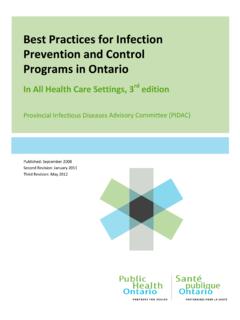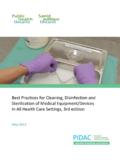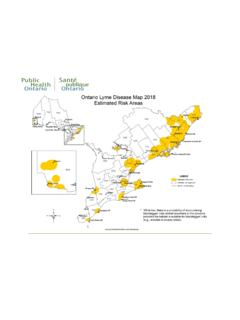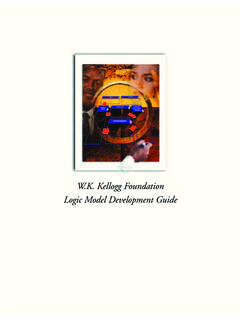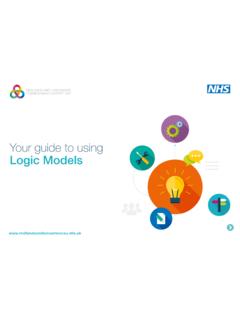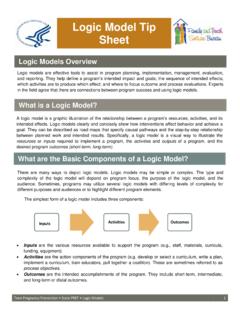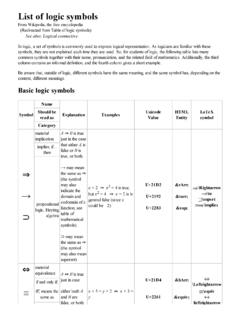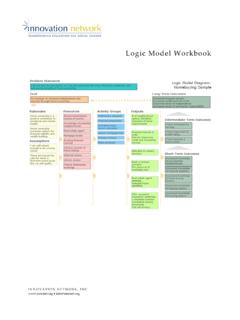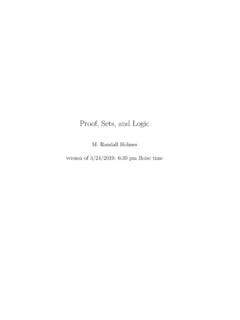Transcription of Focus On: Logic model A planning and evaluation tool
1 Focus On: Logic model A planning and evaluation tool December 2016 Introduction A Logic model is a visual illustration of a program s resources, activities and expected ,2 It is a tool used to simplify complex relationships between various components and can be used during program planning , implementation and ,4 A term that is sometimes used concurrently with Logic models is theory of change. Theory of change is a foundational concept that provides an understanding of the pathway to bring about It clarifies expectations amongst diverse stakeholders and highlights common understanding regarding intended outcomes of the proposed Logic models can be viewed as a representation of the program s underlying theory of change.
2 This document provides an overview of the components of a Logic model , examples of Logic model designs, and describes the use of Logic models in program planning and evaluation . Focus On: Logic model - A planning and evaluation tool Page 2 of 11 Methods The content of this Focus On was developed based on the Logic models webinar presented by Public Health Ontario (PHO). A general search of available resources was conducted through the Google search engine, reviewing existing PHO knowledge products, and input from health promotion consultants within the Health Promotion Capacity Building unit at PHO.
3 Components of a Logic model A Logic model can be as broad or specific as needed, depending on whether it is describing an activity, program, initative, policy or ,9 The design and purpose of one Logic model may differ from another, however there are common components that all Logic models share including a goal, inputs, activities, audience, outputs, and ,5,6,8,9 Table 1 outlines the most commonly used Logic model components and provides examples for each one. Possible additional components are situation, assumptions, external factors, and strategies; 9,10 which are described in Table 2.
4 Table 1. Common components of Logic models Component Description Example Goal The overall long-term health outcomes the program hopes to achieve. To prevent diet-related health problems in adulthood. Inputs The resources invested into a program or initiative. Staff Funding Time Materials Supplies Activities Activities or interventions that will be carried out as part of the program. Public service announcements (PSAs) on health risks of sexually transmitted infections (STIs) Workshops on healthy eating for children and their parents Bi-weekly community sports activities for neighbourhood adolescents Audience Whom the program is targeting.
5 Programs may target specific groups such as young children or older adults but may also be broad in nature. Primary audience: the main population that is being targeted. Secondary audience: groups who are impacted or influenced by a program, but are not the direct recipients of the program. A program designed to train teachers on how to provide physical activity to students. Primary audience: teachers Secondary audience: students Focus On: Logic model - A planning and evaluation tool Page 3 of 11 Component Description Example Outputs Products that are produced from program activities or interventions.
6 Outputs can be viewed as quantifying activities and providing numeric values or attributing percentages. Number of PSAs run during a health promotion campaign Number of workshops provided on healthy eating Percentage of organized community sports activities held Outcomes The changes expected to result from the program. Outcomes range from short-term to long-term, and are associated with changes in knowledge, awareness, behaviour and skills. Increased awareness of the health risks of STIs Increased knowledge on healthy foods and proper food handling skills Reduction in the number of secondary students reporting physical inactivity on school surveys Table 2.
7 Additional possible components of Logic models Component Description Example Situation The situational context that lead to the creation of the program. Increased rates of obesity lead to the creation of a physical activity program for adolescents aged 12 to 18 years old Increased incidence of gonorrhea and low perceived susceptibility to sexually transmitted infections (STIs) amongst 14 to 24 year olds Assumptions Underlying theories and beliefs about the program and its context which can influence the development of a program and which activities are implemented. Transparency around assumptions makes explicit the beliefs that underlie chosen actions.
8 Adolescents are interested in physical activity programs The public has access to a radio and will hear the PSAs External factors Factors that impact the program but are beyond the control of program planners and overseers. Factors may be positive or negative and are likely to influence program success. Cultural norms Political climate Social policies Environmental factors Focus On: Logic model - A planning and evaluation tool Page 4 of 11 Component Description Example Strategies A broad approach or plan to facilitate change. The Ottawa Charter for Health Promotion identifies five strategies to consider when developing health promotion programs: Build healthy public policy Create supportive environments Strengthen community action Develop personal skills Re-orient health services Examples of Logic models Logic models can be simple or complex, and allow for great flexibility in design.
9 They are often shown in a linear fashion for simplicity, logical flow, and ease of understanding;3,8 however, they can be presented in a cyclical model and be as visually engaging as needed. The design of a Logic model is dependent on the type of information that is being presented and the needs of stakeholders (program staff, funders, and community members). Different types of Logic models will be appropriate for different programs what works in one program area may not work in another. Although there are common components, the aim is not a one-size-fits-all approach, rather these components help to streamline and guide the development of the model and help to operationalize program interventions.
10 Figure 1 below outlines a simple Logic model template that can be used as a starting point. Inputs Activities Audience Outputs Short-term outcomes Long-term outcomes Figure 1. Example of a Logic model template Focus On: Logic model - A planning and evaluation tool Page 5 of 11 The additional components listed in Table 2 are often described in a programs theory of change, however, these components can be directly included in the Logic model as well. Figure 2 shows an example of a Logic model which includes the situation, assumptions, and external factors in addition to the common components.


